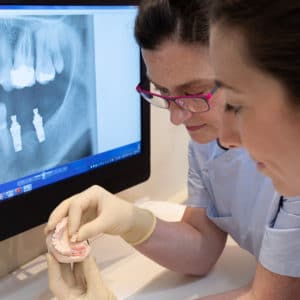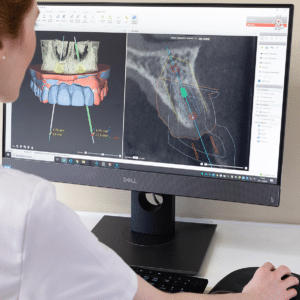A dental implant is a long-term solution for replacing missing teeth. Your dentist places them directly into your jawbone, where they provide an artificial replacement for the root of your missing tooth or teeth.
Dental implants are titanium screw-like fixtures, which are inserted into prepared sites in the jawbone. They may be used alone to support a single tooth crown, or in many different configurations to support several teeth, or a bridge.

Once inserted in the jaw, the bone grows around the implant and anchors it securely. The actual tooth restoration is usually connected to the implant by means of an abutment that screws into the implant, and the dental crown or bridge is then either cemented onto the abutment, or alternatively is itself screwed onto the abutment.
The dental implant technology we use was first developed by a Swedish researcher, Professor Branemark, and was further developed by Nobel Biocare™ a large Swedish / Swiss company. At Dawood and Tanner, we only use the finest quality materials and components available, to improve success rate of treatments and the longevity of the implant itself. Settling for cheap materials can lead to a whole host of problems and it is not advised.

How does surgery take place and what can I expect?
Of course every patient and tooth is unique, but generally implant placement is straightforward and comfortable. The most unpleasant part is the initial numbing-up, which may require two or more local anaesthetic injections.
One to Three Dental Implants may be placed very comfortably in one session under a simple local anaesthetic alone. Some patients may prefer to have implants placed under a local anaesthetic supplemented with sedation.
For multiple fixtures or for patients having Zygomatic implants, many patients are happy to have the surgery carried out under local anaesthetic supplemented with intravenous sedation. In this event, we would ask one of our visiting consultant anaesthetists to administer the sedation. This type of sedation leaves the patient in a very pleasant dreamy state in which they are essentially unaware of what is going on. Following this type of sedation many patients have no recollection whatsoever of the procedure, despite the fact that they may be talking occasionally throughout.
It is not unusual to find that some patients want sedation for one implant and that others do not want sedation even for multiple surgeries. We will always cater to the patient’s preference here, however for very invasive treatments sedation is advised. After surgery a small stud may be visible in the surgical area, although it may alternatively be possible to place a temporary crown or bridge. Many patients simply continue with whatever temporary arrangement existed before surgery.
Our dental implant solutions include:
Please take our Implant Questionnaire for a personal solution, to help you feel more informed and confident about taking up treatment.

What are the benefits of dental implants?
Dental Implants offer a reliable solution for replacing missing or failing teeth. Whether you are missing a single tooth, or all of your teeth, dental implants are the gold standard. An implant provides a solid, long-lasting, and comfortable solution that looks and feels just like your own natural teeth. In addition, an implant when compared with a conventional bridge, allows you to keep the adjacent teeth to the gap intact and is therefore a very conservative approach. Other notable benefits of implants include:
- Maintenance of facial structured and a more youthful appearance due to support in the mouth.
- Improvement of speech, unlike that of dentures which affect pronunciation and natural articulation.
- Bone loss prevention. Stimulation of the jaw bone from implants promotes greater bone mass.
- Cavity free teeth as a result of the materials used in the crown, abutment and screw.
- A better bite force from the high quality titanium screws anchored into the jaw.
Is there always enough bone or gum for treatments?
When teeth are lost, the supporting bone also tends to be lost over a period of time. Bone loss proceeds rapidly if there is or has been infection around a tooth and the amount of bone very often dictates the complexity of treatment.
Where there is ample bone present it should be possible to produce an excellent cosmetic result, especially when restoring small areas. Where there is just adequate bone, the procedure may still be straightforward, but there may be an element of compromise, e.g. the teeth may look longer, or it may be necessary to add pink gum work onto an implant bridge or crown to give the impression of a normal length tooth.
Where bone is in a poor state it may be necessary to consider reconstruction of the area to replace missing bone, just to enable us to place the implant. It is also sometimes necessary to reconstruct the area with bone or gum in order to improve the appearance.
The implant process at Dawood and Tanner:
1. Consultation and Treatment Planning
The first stage of the dental implant process involves a full mouth assessment including X-rays and 3D imaging. We were the first to introduce Cone Beam Computed Tomography (CBCT) to the UK, and to use the technology routinely at this stage, to the great benefit of our patients at our state of the art facility, widely regarded as setting the gold standard in the field. After this process, a treatment plan letter with exact costs and time scales is sent to you. A second consultation may take place where we may take photographs and impressions of your teeth to meticulously plan implant treatment.

2. Implant Placement
Patients usually spend 1½ hours at the practice for routine implant placements. Most patients are able to leave soon after their treatment and return to their daily activities.
This is a relatively minor surgical procedure and is most often carried out with a local anaesthetic. Once the implant has been placed, the gum is closed over using fine, dissolvable stitches. These stitches usually disappear after 2-3 weeks.
If we are creating a temporary crown or a bridge for you on the day of your implant placement, allow 3-5 hours (depending on complexity) for this to be fabricated by our in-house laboratory. During this time, you can relax in one of our private recovery rooms.
3. Review
The next appointment is usually around 2 weeks after the implant surgery in order for the implant surgeon to check the area where the implants have been placed and ensure you’re healing well. Any remaining stitches may be removed and if a temporary restoration has been provided, we will want to be certain that the biting surface is even.
4. The Healing Period
The healing period varies depending on the complexity of the implant placement, and this can be anywhere between 2 – 6 months. During this healing period, the process referred to as “osseointegration” – where the implant integrates with the surrounding bone takes place and also allows the gums to heal. During the healing period, the implant area should be completely comfortable.
5. The Restoration Period
The implant surgeon will remove the healing abutment or temporary restoration and impressions will then be taken of the tooth/teeth which are sent to our laboratory to begin the process of making your permanent crown, bridge or denture. This can take between 2-6 appointments depending on the type of restoration required to restore your smile. Once you are happy with the look of your final restoration it will either be screwed into place or it will be cemented in.
6. Maintenance
Dental Implants and their restorations are susceptible to similar conditions to those that affect natural teeth such as gum disease. Regular visits to your hygiene therapist and excellent oral hygiene at home is a lifetime commitment that will help you give your implants the greatest longevity.
Why choose Dawood and Tanner for your treatment?
Dr Andrew Dawood and our Dental Implant team, have placed thousands of dental implants for patients with missing or badly restored teeth. In over 25 years we have streamlined the dental implant surgical process to make it a frictionless experience for the patient, and one in which they can be assured of having the best possible outcome and longevity.
We only use Nobel Biocare™ implants and components as they are in our opinion the market leaders in dental implants and we have been using them with exemplary results. By comparison, many “low cost” implant systems and restorative protocols do not have the same degree of scientific and practical support behind their use. We are proud that many of our patients who had dental implants placed over 25 years ago continue to have healthy and trouble free implants and restorations!
Our dental implant surgeries often take as little as an hour and a temporary tooth or bridge (your same day smile) is placed. The definitive tooth prosthetic restoration is then refined to beautifully match the shape and shade of your own teeth.
In addition to our carefully designed surgeries, we have a dental imaging suite, and a surgical theatre at the practice, so all of your appointments are in one place. You will have a dedicated treatment coordinator who will guide you through your dental implant process, and will be available to discuss any questions you may have. You can have peace of mind knowing that your treatment is with a long established practice in the UK, and importantly our prices include all the original components. Contact us today to book a consultation or treatment.

